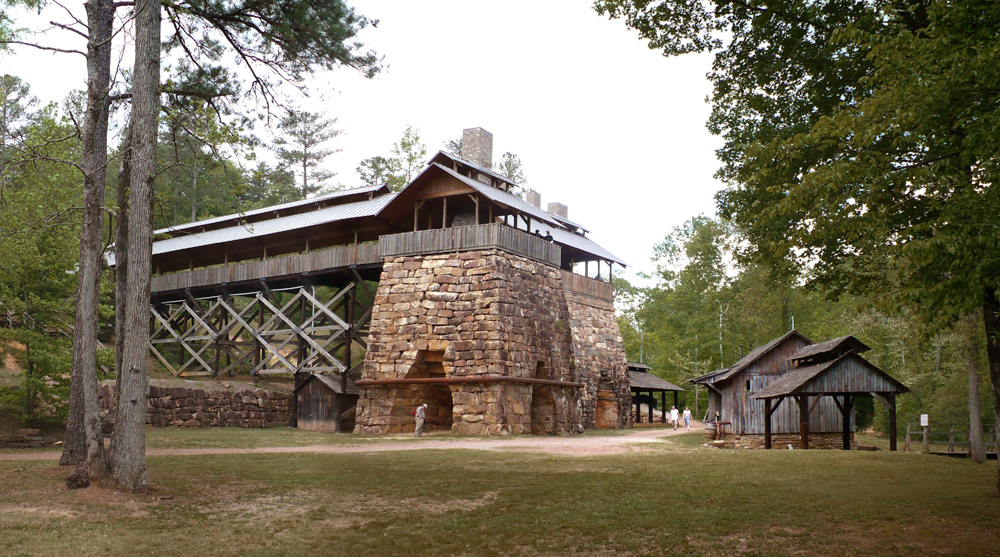- Tannehill Ironworks
Infobox_nrhp | name =Tannehill Ironworks
nrhp_type =

caption =
location= Tuscaloosa County,Alabama , USA
lat_degrees = 33 | lat_minutes = 14 | lat_seconds = 51 | lat_direction = N
long_degrees = 87 | long_minutes = 4 | long_seconds = 4 | long_direction = W
area =
built =1859-62
architect=
architecture=
added =July 24 ,1972
governing_body = Alabama Historic Ironworks Commission
refnum=83002974 cite web|url=http://www.nr.nps.gov/|title=National Register Information System|date=2007-03-16|work=National Register of Historic Places|publisher=National Park Service]The Tannehill Ironworks is a state historic site in Tuscaloosa County near
Bessemer, Alabama ,USA Listed on the
National Register of Historic Places , it was a major supplier of iron for Confederate ordnance. Remains of the old furnaces are the central attraction of Tannehill Ironworks Historical State Park located convert|12|mi|km|0 south of Bessemer, Alabama off I-59/20 near the southern end of theAppalachian Mountains .The 1,500 acre (6 km²) historical park also includes the John Wesley Hall Grist Mill, May Plantation Cotton Gin House and the
Iron & Steel Museum of Alabama .Ironmaking at the site began with construction of a bloomery forge by Daniel Hillman Sr. in 1830.
Built by noted southern ironmaster Moses Stroup from 1859 to 1862, the three charcoal blast furnaces at Tannehill could produce 22 tons of pig iron a day, most of which was shipped to the Naval Gun Works and Arsenal at Selma. Furnaces Nos. 2 and 3 were equipped with hot blast stoves and a steam engine. Brown iron ore mines were present two miles (3 km) distant. [Ethel Armes, The Story of Coal and Iron in Alabama, Re-print edition, Book-Keepers Press, 1972, 158.]
The Tannehill furnaces and its adjacent foundry, where kettles and hollow-ware were cast for southern troops, were attacked and burnt by three companies of the U.S. 8th Iowa Cavalry on March 31, 1865 (
Wilson's Raid ). The ruins remain today as one the best preserved 19th century iron furnace sites in the South. [James R. Bennett, Tannehill and the Growth of the Alabama Iron Industry, Alabama Historic Ironworks Commission, Second Edition, 2005, 152-154.]Also known as the Roupes Valley Iron Company, these works had significant influence on the later development of the
Birmingham iron and steel industry. An experiment conducted at Tannehill in 1862 proved red iron ore could successfully be used in Alabama blast furnaces. The test, promoted by South & North Railroad developers, led to the location of government-financed ironworks in the immediate Birmingham area (Jefferson County). [Bennett, Tannehill and the Growth of the Alabama Iron Industry, 95-96.]The furnace remains, including reconstructed portions, are an
American Society for Metals historical landmark [ [http://www.asminternational.org/Content/NavigationMenu/Membership/AwardsProgram/HistoricalLandmarks/Landmarks.htm ASM Historical Landmarks] - accessed August 2, 2007] and have been designated as a [http://www.civilwar.org/CWDT/ Civil War Discovery Trail] site. The park attracted over 425,000 visitors in 2005. [Alabama Department of Tourism and Travel, Montgomery, Alabama.]References
External links
* [http://www.tannehill.org/ Tannehill Ironworks Historical State Park] website
* [http://www.alaironworks.com/furnace/tannehill.htm Tannehill Furnaces] page in the Alabama Ironworks Source Book
Wikimedia Foundation. 2010.
